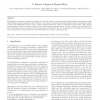113
Voted
JSS
2010
14 years 7 months ago
2010
In this paper we investigate the effect of three time-triggered system rejuvenation policies on service availability using a queuing model. The model is formulated as an extended ...
206
Voted
AUTOMATICA
2011
14 years 7 months ago
2011
Fluidification constitutes a relaxation technique for studying discrete event systems through fluidified approximated models, thus avoiding the state explosion problem. Moreove...
161
Voted
BIRTHDAY
2010
Springer
14 years 9 months ago
2010
Springer
Abstract Queueing Petri nets are a powerful formalism that can be exploited for modeling distributed systems and analyzing their performance and scalability. By combining the model...
119
Voted
ICFEM
2009
Springer
14 years 10 months ago
2009
Springer
Bounded timed-arc Petri nets with read-arcs were recently proven equivalent to networks of timed automata, though the Petri net model cannot express urgent behaviour and the descri...
118
Voted
NC
2010
14 years 10 months ago
2010
Abstract. In the last fifteen years, several research efforts have been directed towards the representation and the analysis of metabolic pathways by using Petri nets. The goal o...
116
Voted
TSE
2002
15 years 1 days ago
2002
Fluid (or Hybrid) Petri Nets with flush-out arcs are Petri net based models with two classes of places: discrete places that carry a natural number of distinct objects (tokens), a...
104
Voted
TSMC
1998
15 years 2 days ago
1998
—The paper discusses how Petri nets may be used for the qualitative modeling of physical systems. The qualitative state of a system is represented by the marking of the net. The ...
114
Voted
TC
1998
15 years 2 days ago
1998
—The achievement of media synchronization has been dealt with in the Object Composition Petri Net (OCPN) model and the extended OCPN (XOCPN) model. Yet these two models are not e...
113
Voted
JCSC
1998
15 years 2 days ago
1998
For many years, Petri nets have been used for modeling the behavior of various types of concurrent systems. While these net models are especially well suited to capture the behavi...
118
Voted
INFORMS
1998
15 years 2 days ago
1998
High-level formalisms such as stochastic Petri nets can be used to model complex systems. Analysis of logical and numerical properties of these models often requires the generatio...





